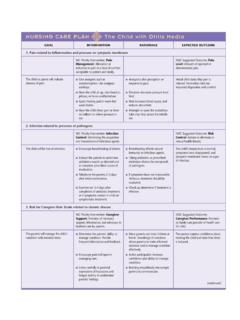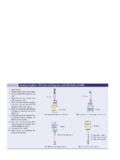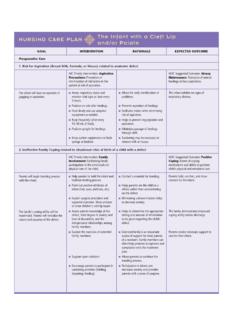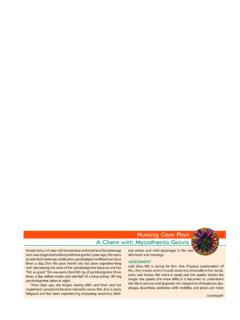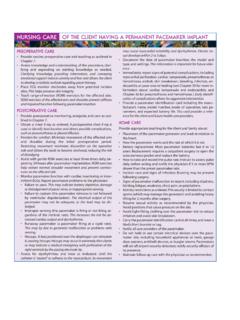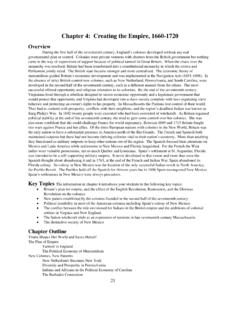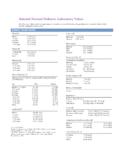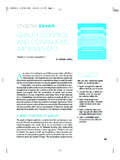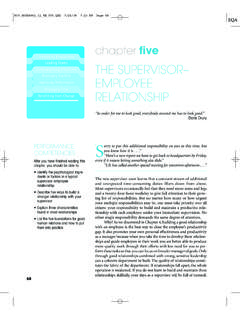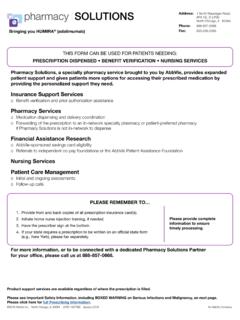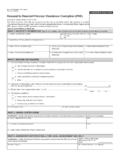Transcription of PROCEDURE 13-1 Bathing Clients - Pearson Education
1 The client and the environment. Invite a parent or family member to participate if desired. Close the windows and doors to make sure that theroom is free from drafts. Air currents increase loss of heatfrom the body by convection. Provide privacy by drawing the curtains or closing thedoor. Hygiene is a personal matter. Some agencies providesigns indicating the need for privacy. Offer the client a bedpan or urinal or ask whether theclient wishes to use the toilet or commode. The clientwill be more comfortable after voiding, and voiding beforecleaning the perineum is advisable. During the bath, assess each area of the skin A BED the bed, and position the client appropriately. Place the bed in the high position. Place an infant orsmall child on a changing table or elevated crib. Thisavoids undue strain on the LPN/LVN s back. Remove the top bed linen and replace it with the bathblanket. If the bed linen is to be reused, place it overthe bedside chair.
2 If it is to be changed, place it in thelinen hamper. Assist the client to move near you. This helps preventundue reaching and straining. Remove the client s a bath mitt with the washcloth (Figure 13-12 ).A bath mitt retains water and heat better than a clothloosely held. Triangular method: (1) Lay your hand on the washcloth;(2) fold the top corner over your hand; (3, 4) fold theside corners over your hand; (5) tuck the second cornerunder the cloth on the palmar side to secure the mitt. Rectangular method: (1) Lay your hand on the wash-cloth and fold one side over your hand; (2) fold the sec-ond side over your hand; (3) fold the top of the clothdown; and (4) tuck it under the folded side againstyour palm to secure the the face. Place one towel across the client s chest. Wash the client s eyes with water only and dry themwell. Use a separate corner of the washcloth for eacheye. Using separate corners prevents transmission of microor-ganisms from one eye to the other.
3 Wipe from the inner tothe outer canthus. Cleaning from the inner to the outer can-thus prevents secretions from entering the nasolacrimal ducts. Ask whether the client wants soap used on the has a drying effect, and the face, which is exposed to theair more than other body parts, tends to be drier. Wash, rinse, and dry the client s face, neck, and ClientsPURPOSES To remove transient microorganisms, body secretions andexcretions, dead skin cells, and normal secretions and odors To stimulate circulation to the skin To produce a sense of well-being To promote relaxation and comfort To prevent or eliminate unpleasant body odors To maintain skin integrityEQUIPMENT Bedpan or urinal Changing table Bath blanket Gloves (if giving perineal care) Washcloth Soap Washbasin Water between 43 and 46 C (110 and 115 F) for adults,38 and 40 C (100 and 105 F) for children Two bath towels Additional bed linen and towels, if required Hygiene supplies such as lotion and deodorant Clean gown or pajamas as needed Cotton balls or swabs Solution bottle, pitcher, or container filled with warmwater or a prescribed solution Bedpan to receive rinse water Moisture-resistant bag or receptacle for used cotton swabs Moisture-resistant disposable pad Pillow (optional) PROCEDURE 13-1 Part A: Bathing an Adult or Pediatric Client254 Unit III Promoting Physiologic 04/22/2005 03:52 PM Page 254 EQAC hapter 13 the arms and hands.
4 (Omit the arms for a partial bath.) Place the bath towel lengthwise under the arm. It pro-tects the bed from becoming wet. Wash, rinse, and dry the arm, using long, firm strokesfrom distal to proximal areas (from the point farthestfrom the body to the point closest). Firm strokes fromdistal to proximal areas increase venous blood return. Wash the axilla well. Repeat for the other caution if an intravenous infusion is present,and check its flow after moving the arm. Immediatelyreport any problems with the IV to the RN. Place a towel directly on the bed and put the basin onit. Place the client s hands in the basin. Many clientsenjoy immersing their hands in the basin and washing them-selves. Assist the client as needed to wash, rinse, anddry the hands, paying particular attention to the spacesbetween the the chest and abdomen. (Omit the chest andabdomen for a partial bath. However, the areas under awoman s breasts may require Bathing if they are irritated.)
5 Fold the bath blanket down to the client s pubic area,and place the towel alongside the chest and abdomen. Wash, rinse, and dry the chest and abdomen, givingspecial attention to the skinfold under breasts. Keepchest and abdomen covered with the towel between thewash and rinse. This provides warmth and privacy. Replace the bath blanket when the areas have beendried. Avoid undue exposure when washing the chestand abdomen. For some Clients , it may be preferable towash the chest and the abdomen separately. In thatcase, place the bath towel horizontally across theabdomen first and then across the the legs and feet. (Omit legs and feet for a partialbath.) Wrap one of the client s legs and feet with the bathblanket, ensuring that the pubic area is well covered. Place the bath towel lengthwise under the other leg,and wash that leg. Use long, smooth, firm strokes,washing from the ankle to the knee to the from distal to proximal areas stimulates venousblood flow.
6 Rinse and dry that leg, reverse the coverings, andrepeat for the other leg. Wash the feet by placing them in the basin of water. Dry each foot. Pay particular attention to the spacesbetween the toes. If you prefer, wash one foot after thatleg, before washing the other leg. Obtain fresh, warm bathwater now or when may become dirty or cold. Because surface skin cells areremoved with washing, the bathwater from dark-skinnedclients may be dark; however, this does not mean the client is the back and then the perineum. Assist the client to turn to a prone position or side-lying position facing away from you, and place the bathtowel lengthwise alongside the back and buttocks. Wash and dry the back, buttocks, and upper thighs,paying particular attention to the gluteal folds. Avoidundue exposure of the client, as for the abdomen andchest in Step 6. Assist the client to the supine position, and determinewhether the client can wash the perineal genital areaindependently.
7 If the client cannot do so, drape theclient as shown in Figure 13-13 and wash the also PROCEDURE 13-1, Part 13-12 Making a bath 13-13 Draping the client for perineal genital 04/22/2005 03:52 PM Page 255 EQA256 Unit III Promoting Physiologic the client with grooming aids such as lotion ordeodorant. Help the client to put on a clean gown or pajamas. Assist the client to care for hair, mouth, and nails. Somepeople prefer or need mouth care prior to the pertinent data. Record assessments, such as excoriation in the foldsbeneath the breasts or reddened areas over bony promi-nences and report changes to the RN. Record the type of bath given ( , complete, partial,or self-help). This is usually recorded on a A TUB BATH OR the client and the tub. Fill the tub about one-third to one-half full of water at43 to 46 C (110 to 115 F). Sufficient water is needed tocover the perineal area. Cover all intravenous catheters or wound dressingswith plastic coverings, and instruct client to preventwetting these areas if possible.
8 Obtain assistance with holding a pediatric client as indi-cated. Holding minimizes contamination of open skin areas. Apply a rubber bath mat or towel to the floor of thetub if safety strips are not on tub floor. These preventslippage of the client during the bath or shower. Use a small basin or large sink for a small containers decrease the danger of slippage of an activechild and possible the client into the shower or tub. Assist the client taking a standing shower with the initialadjustment of the water temperature and water flowpressure, as needed. Some Clients need a chair to sit in theshower because of weakness. Elderly people often feel faint underhot water. If the client requires considerable assistance with a tubbath, additional staff may be needed. To provide support asthe client sits down in the tub, fold a towel lengthwise andplace it around the chest under both axillae; then hold theends securely at the back as the client sits.
9 It may be help-ful to seat the client on the edge of the tub or on a chairbeside the tub before transferring the client into the tub. Explain how the client can signal for help, leave theclient for 2 to 5 minutes, and place an Occupied signon the door. Never leave an infant or small pediatric client unat-tended in a tub. Slippage and drowning can occur in amatter of seconds and in very little the client with washing and getting out of the tub. Wash the client s back, lower legs, and feet, if necessary. Assist the client out of the tub. If the client isunsteady, place a bath towel over the client s shouldersand drain the tub of water before the client attempts toget out of it. Draining the water first lessens the likelihoodof a fall. The towel prevents the client, and assist with follow-up care. Follow Step 9. Assist the client back to the room. Clean the tub or shower in accordance with agencypractice, discard used linen in the laundry hamper, andplace the Unoccupied sign on the pertinent data.
10 Follow Step B: Providing Perineal Genital the client. Offer the client an appropriate explanation, being partic-ularly sensitive to any embarrassment felt by the client. Determine whether the client is experiencing any dis-comfort in the perineal genital area. Fold the top bed linen to the foot of the bed, and foldthe gown up to expose the genital area. Place a bath towel under the client s hips. The bath towelprevents the bed from becoming and drape the client, and clean the upper FEMALES Position the female in a back-lying position, with theknees flexed and spread well apart (abducted). Cover her body and legs with the bath blanket. Drape the legs by tucking the bottom corners of thebath blanket under the inner sides of the legs(see Figure 13-13). Minimum exposure lessens embar-rassment and helps to provide warmth. Bring the middleportion of the base of the blanket up over the pubicarea. Don gloves, and wash and dry the upper inner MALES Position the male client in a supine position withknees slightly flexed and hips slightly externallyrotated.

